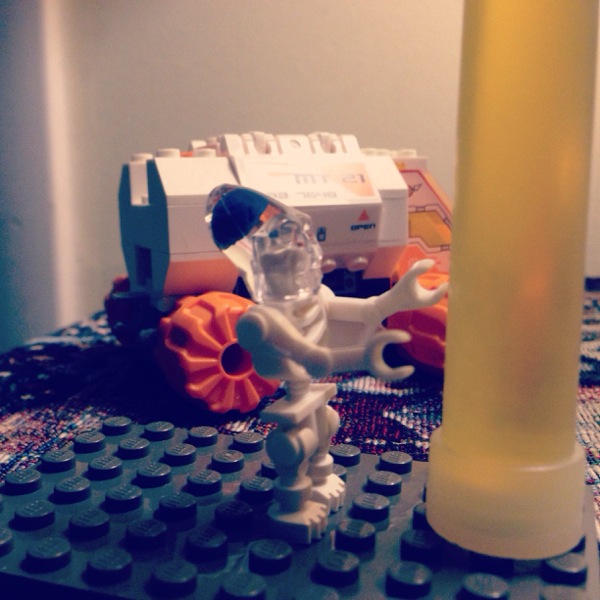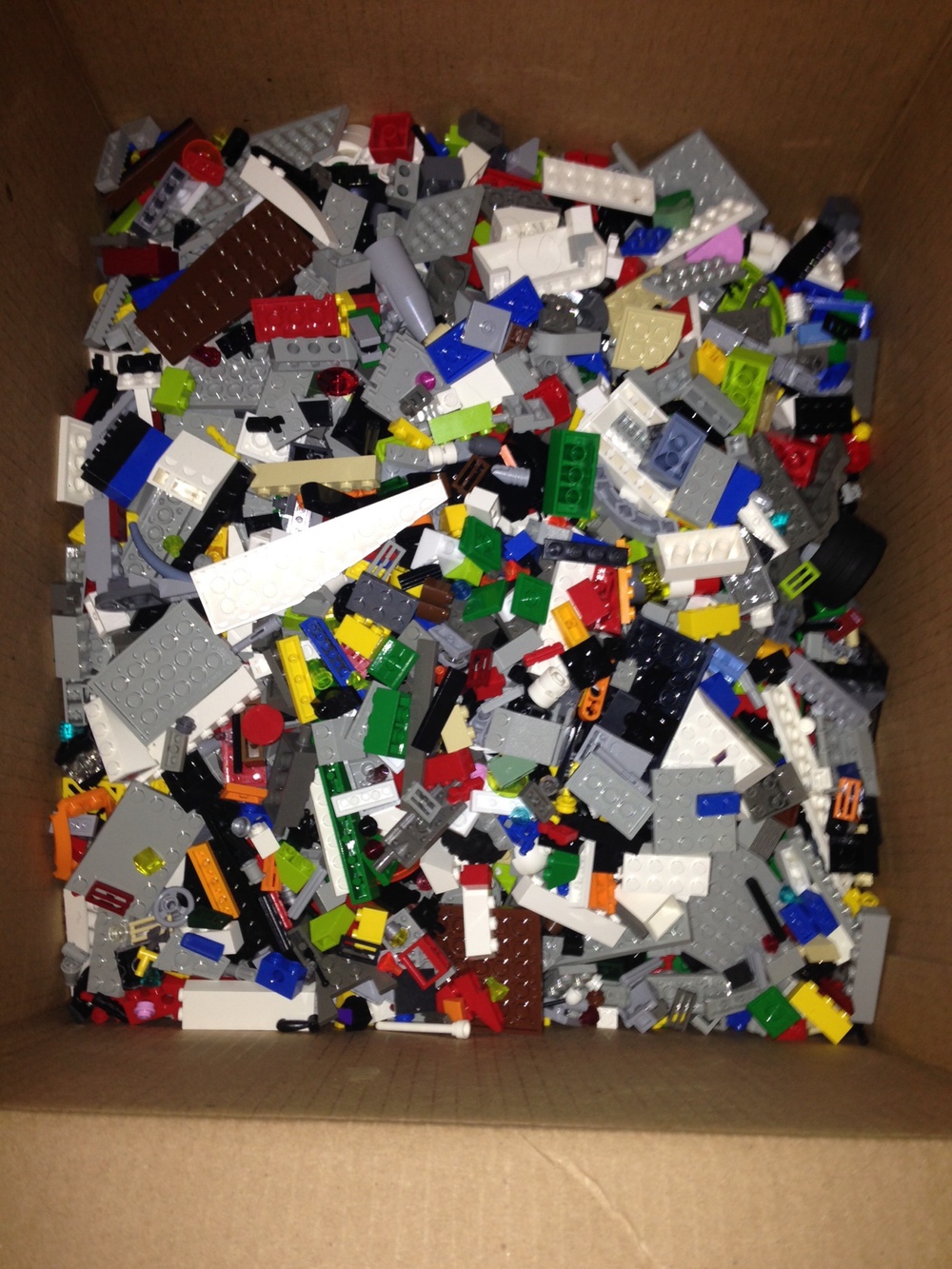My LEGO MOC of habitat modules for a Mars mission and how I'd set up the first colony
I originally intended to do any entire Mars mission out of LEGO, I have most of the elements I need for the rocketry, return vehicle, exploration vehicle, etc., but five months ago I did the habitats and stopped. I'll get around to finishing everything eventually. I had thought I posted this MOC on this blog, but it appears I haven't, so here it is!
I have about 18.5 m2 of PV panels displayed in the model which would provide about 1415w at high noon on Mars during the Martian winter (1851w in the summer), the tanks have been launched and landed ahead of time mostly empty containing ISRU units to generate/capture usable things from the atmosphere. Probably WAVAR for one of the ISRU units which upon landing could quickly be used for starting soil washing experiments and/or hydroponics, if near the northern polar region you could take your time harvesting water ice for melting, you could also have some of the water from the WAVAR going to a second ISRU purely to make oxygen and hydrogen, you could also have one making monopropellant hydrogen peroxide for the return mission and/or return samples. In the event of a dust storm, which can last months or more, the PV panels would be mostly worthless; however, the stored oxygen and hydrogen could be used with a fuel cell to provide energy for the habitat modules.
I didn't picture an RTG as I plan to have one of the vehicles using an RTG for processing water ice (the waste heat to melt the ice and warm the passenger cabin), this vehicle could be plugged into the habitat modules to provide heat and emergency energy in the event of a prolonged storm as leaving the habitat modules would be a bad idea due to severely reduced visibility.
If I were to establish a Mars colony here are my initial thoughts on how I'd go about doing it.
Habitat
In the early days, I'd start with inflatables as I've shown above in LEGO elements. But Ryan, what about radiation shielding?
It's not as big of an issue as you'd suspect. You aren't going to be living/temporarily living in clear nylon inflated bubbles. Yes, you'll pick up more rads if you are living in an unshielded habitat, but shielding it is going to be quite easy if you have even modest mechanical means of moving regolith.
Worst case for a non-permanent mission, the areas of the habitat you spend most of your time in have the water stored in the walls and ceiling.
Quick shielding for more permanent living, you take a strong, but light, material like Nylon 6 with you ultra-light metal poles. You place the poles around the habitat you then weave the material between them (think 'under over') and then spend your first few days using modestly powered Martian wheelbarrow to scoop and move regolith between the material and the habitat except for shielded doors. Again, have some of the water stored in the top of the modules for the hours the sun is overhead. OR make a simple machine that fills sandbags, the sandbags would require more material (fabric/plastic) but would likely be quicker than carting regolith around.
With my example in LEGO, I'd have the inflatable modules I have shown then come in with poles spaced out like fence posts, something like Nylon 6 sheeting woven between the poles and then fill the space with regolith. For a more long term shielding, your habitats are mostly underground, OR you use regolith as a component for making bricks and stack bricks around the hab modules.
Water
Depending on where you land will matter here. If you wanted to land near the northern polar cap you'd find 821,000 cubic kilometers of water ice available for exploitation, elsewhere you'd have to find it in the regolith or get lucky and drill and hope to find an underground water source near a geologically active area that is pumping out geothermal energy (which you might want to do for heating and energy production anyway).
For this post, I'm going to assume we are setting up camp near the northern polar cap, farther south than the cap gets during the winter. From here, you'd need a vehicle that was capable of a week or longer trips. You'd drive all day and park at night. Ideally, you could make it to ice in 3 days or less, you'd then determine concentrations of water ice, and cut/hammer/pick out as much as you can fit into a storage compartment and then drive back. You'd also want a second vehicle at the base so a rescue party could come and get you in the event the vehicle became stuck or otherwise disabled.
Now, you need to melt that ice. With power being a precious commodity on Mars, I've had thoughts on how to do this.
The 'cheapest' method is going to be using the sun directly, basically put the ice in a sealed, transparent, greenhouse and use reflectors to concentrate more sunlight on a given space to raise the temperature. Place ice in, seal, pressurize, open the valve in a funneled floor, let the sun do its work. Use a solar tracking system to adjust enough reflectors while it melts, and the water collects in a tank. With the melting done, close drain valve and vent pressure. Since no one is in the box, you don't even have to use breathable air; simply pump the Martian atmosphere into the box in a high enough concentration to assist with the heating of the box.
The second option, so Mars averages 57% of the solar irradiance that earth gets. The average temperature on Mars is -55C. Doing some quick math in my head you'd likely need a little less than 0.5KWh to melt 1kg of ice and to get it slightly above freezing so you'll need about 6 square meters of PV panel to thaw 2kg an hour of ice, that's about 2 liters of water an hour assuming it's pure water ice and doesn't contain any dry ice or meteorites of appreciable size.
I'm going to use the potatoes everyone knows about from The Martian for this to give us an idea of how much water might be needed. Now, it takes about 34 gallons of water to grow a pound of potatoes, that's almost 129 liters. Keep in mind you'll be keeping the water you wash soil with and growing in a sealed greenhouse losing minimal amounts to air exchange in an airlock. The water content of the potato itself will almost entirely be recaptured, as well. So, you'd need 8-10 days to melt enough ice to grow a pound of potatoes if you go the PV route. If you went the solar reflector route, you'd be melting a hell of a lot quicker and need about the same weight of materials.
Making a colony make economic sense, funding the effort
Aha, now this is the real key to settling Mars, making money to fund sending more humans and cargo.
If a private company, or more likely consortium of companies from various industries, could cough up 500bn (for reference, Apple reported a NET income of 53.39bn in 2015 and has 200bn~ in cash, the fortune 500 top 10 earners reported 210bn in NET profits in 2014) ...
Let's be conservative and pretend a private company would need 20bn per 5 flights. Let's say 1 equipment launch per 4 manned launches. I believe Mars Direct called for 3 people for the early flights, but let's pretend 5 per flight.
You get 100 people and a hell of a lot of equipment and habitats to Mars for 500bn over 10-16 years and then BOOM. Declare yourself a nation.
You sell land claims, you license technologies, you tax import, but instead of a financial cut, you get paid in cargo space or human passage. Screw the various space treaties/agreements, the backing companies spend plenty of money on lobbyists the world around and could get a few countries minimum to exit those agreements and recognize the new government.
You take those human passage spaces taken as tax and use them to hire via employment contracts. You get passage to Mars as well as room, board for working for us for x years, and you also earn this many Marsbucks per month. Any mineral deposits, discoveries, inventions, etc. you make while under your initial contract, the Martian Free Government gets 10% royalties on gross profits and may use any technologies or processes for free.
You also work with other companies that want to send people to Mars. "You will be granted access to such and such, an xx year land lease for a nominal amount, in exchange you will give 5% of any profits that arise from your operations on Mars whether or not sold on Mars or not".
Inside of 50 years from the first landing of humans, you'd mostly have Mars locked down. If any wildcat colonies tried to land, it'd likely be far from your settlement, and they wouldn't be an issue for centuries. If armed forces attempted to come and be a problem if they were from a Terran government, that government would likely find themselves screwed politically as soon as the news made its way back to earth.
Recommended reading:
How to Live on Mars: A Trusty Guidebook to Surviving and Thriving on the Red Planet

























